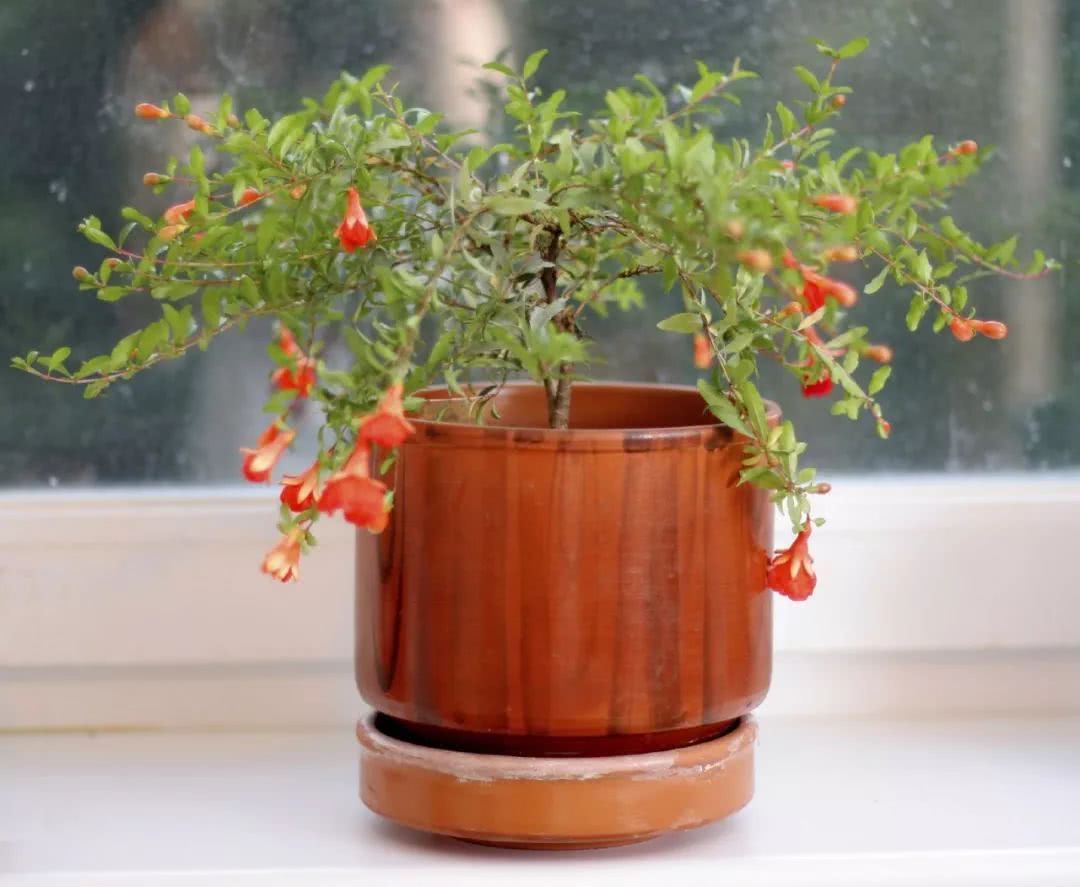The pomegranate can also blossom and bear fruit in the flowerpot and become a charming landscape on the balcony.

Pomegranate is a very delicious fruit, which can usually be seen in the first or second generation garden. it can be used as a very charming landscape tree, because its flowers are not low in ornamental, but also can bear fruit, and they are rich in varieties. Its flowers are red flowers, and even have special varieties of flowers.
Pomegranate is different from other fruit trees, its root system is very shallow, so pomegranate can grow well when planted in flowerpots.
If you want pomegranate to grow healthily, you need to provide it with a suitable environment. It can grow into shrubs or trees, up to six meters high, and in flowerpots, the plant type can be controlled below two meters.
To cultivate pomegranate, you should choose some humus or sandy soil that is loose, breathable and well drained. It likes neutral soil. The drainage of cultivated soil must be good, and the stagnant water in the soil is easy to rot the roots.
The cultivation of pomegranate is best to choose a heavier pottery basin or tile basin, otherwise it is easy to lead to top-heavy, its drainage is also good, to avoid soil water.
The pomegranate tree has a very attractive appearance, the leaves are spear-shaped, the leaves have a bronze luster, and the leaves become green when they mature.
Pomegranate flowers are bell-shaped, usually bright red, and look very charming. Now we can also see some pink, cream and white pomegranate flowers, in fact, the most attractive pomegranate is its fruit, the fruit is generally yellowish brown, reddish brown or bright red, especially good ornamental, drooling.
There are many varieties of pomegranate, the most common of which are sapphire pomegranate, giant pomegranate, big white pomegranate, Taishan red pomegranate and so on.
In addition to the pomegranate varieties that can bear fruit, there are also some pomegranates specially used to watch flowers, which can produce brilliant and charming orange or red flowers in summer and autumn and cannot bear fruit.
Pot maintenance of pomegranate flowers is to maintain a warm and humid environment all the year round, the best temperature for maintenance is above 18 degrees, and the lowest maintenance temperature is higher than 7 degrees.
You can use branch cuttings to reproduce pomegranates, which makes it easier to get fruit, and sowing to reproduce stones can also blossom and bear fruit, but it takes a long time.
Sowing and reproducing pomegranates is very simple. You can take the seeds directly from the ripe pomegranate fruit, wash them, wipe them with a paper towel, and dry the seeds in a place with scattered light.
After drying, the seeds can be sown directly, and the best sowing time is after the spring is warm, and it can be buried about one centimeter under the soil. You can put a plastic bag on the seedling pot to keep the soil moist, and it will soon take root and sprout. It usually takes about 1 to 6 weeks.
I suggest using the method of cutting propagation to cultivate pomegranate, so it is easy to blossom and bear fruit. You can choose a branch about 12 to 15 centimeters long, remove the leaves at the bottom, cut diagonally at the bottom, and touch a little rooting powder. Cuttings are cut in loose and drained sandy soil to keep the soil moist and will soon take root and sprout.
When the branches of pomegranate grow to a larger height, the plant type can be properly trimmed and the pot can be changed once every 2 to 3 years.
If you want pomegranate trees to blossom and bear fruit normally, the maintenance position must have as much light as possible, and there must be more than eight hours of direct light every day. Only in this way can pomegranate trees blossom and bear fruit. In places where there is not enough sunlight, there will be little or no flowering.
Pomegranate trees preserved in pots should be watered regularly to avoid long-term drought, keep the soil moist in spring and summer, and start to control water in autumn and winter to avoid soil moisture.
Want to let potted pomegranate trees bear fruit, but also pay attention to regular fertilization, in spring and summer season is usually given once every two weeks, occasionally give some organic liquid fertilizer, pot bottom can also add some mature organic fertilizer, this helps to promote flowering, but the concentration of fertilization must not be too high.
- Prev

A fierce flower friend cuttings a section of green apple branches into a large pot of green apple in only 20 days.
Most flower lovers who have raised green pineapple know that green pineapple is very easy to breed. Just cut a piece of green radish branch into hydroponic culture, or insert it directly into the soil, but is it particularly slow to do so? The flower friend below is very impressive, only.
- Next

I'm sorry, my fault. I shouldn't have disturbed your world.
Do you like this article in the first chapter? Share it now and let more people know! The content of this site is rich, broad and profound, editors select daily hot information, update at any time, click "receive the latest information first" to browse it! Please.
Related
- Wuhan Hospital Iron Tree Blooming Result Was Instantly Frightened by the Gardener Master
- Which variety of camellia is the most fragrant and best? Which one do you like best?
- What is the small blue coat, the breeding methods and matters needing attention of the succulent plant
- Dormancy time and maintenance management of succulent plants during dormancy
- Minas succulent how to raise, Minas succulent plant pictures
- What are the varieties of winter succulent plants
- How to raise succulent plants in twelve rolls? let's take a look at some experience of breeding twelve rolls.
- Attention should be paid to water control for succulent plants during dormant period (winter and summer)
- Watering experience of twelve rolls of succulent plants
- Techniques for fertilizing succulent plants. An article will let you know how to fertilize succulent plants.

